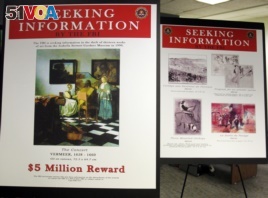14 April, 2019
The U.S. Federal Bureau of Investigation (FBI) went into action when a 17th century Dutch painting turned up for sale in New York City. The painting was last seen during World War II, when it was seized by pro-German forces.
FBI officials learned of the sale in late 2017. A short time later, the FBI's Art Crime Team recovered the painting and, with the help of a court order, worked to return the piece to its rightful owners.
It was the latest of many major theft cases for the 22-person FBI office that works to solve art-related crimes. The office is part of a federal agency best known for chasing bank robbers, spies and other criminals.
Solomon Koninck's 17th-century painting "A Scholar Sharpening His Quill," was one of many treasures belonging to the family of art collector Adolphe Schloss. The artworks were stolen by the Vichy government in France 75 years ago. The painting was once in the Munich office of German leader Adolph Hitler, but it disappeared at the end of World War II.
The piece showed up at Christie's auction house in New York. Christie's told the FBI last year that a Chilean art seller was trying to sell it.
"The evidence was really overwhelming," FBI Special Agent Chris McKeogh told the Reuters news agency. McKeogh worked to return the painting to the Schloss family in early April. "There was really no question that this was the painting in question," he added.
Robert Wittman is the Art Crime Team's founding chief. In its early days, he recalls that working to recover missing artwork was not exactly "a path to directorship."
Fourteen years later, the team is getting more respect from other members of the agency. They have had several notable recoveries in the United States of art works and other cultural property, said Supervisory Special Agent Tim Carpenter.
"People just think what we're doing is cool," said Carpenter. He now directs the office from the FBI's headquarters in Washington.
"So now my phone rings...weekly for folks wanting to be on the team," he said.
Since it was founded in 2005, the team has recovered nearly 15,000 objects worth nearly $800 million.

FBI posters displaying works by artists Johannes Vermeer and Edgar Degas are seen during a press conference held to appeal to the public for help in returning artwork stolen in 1990 from the Isabella Stewart Gardner Museum in Boston, Massachusetts.
Chagall, Renoir and Ruby Slippers
In the past year, the agents recovered a painting by Marc Chagall. It had been taken from a New York home nearly 30 years earlier. Agents also found a painting by Auguste Renoir. Like the Dutch painting, it too was seized during World War II.
But it was the recovery of the "ruby slippers" that made the Art Crime Team famous. Actress Judy Garland wore them when she played Dorothy in the 1939 movie "The Wizard of Oz." Today those shoes are worth millions of dollars.
Carpenter explained that it is not the money, but the "intrinsic value" of stolen art and cultural property that helps the FBI decide if it will open a case.
The ruby slippers were a good example. They were stolen 13 years ago from the Judy Garland Museum in Minnesota.
"People ... said this is really important; this is a piece of Americana," he said.
Agents who work on the team must understand why art and culture are important to humanity, Carpenter said.
Unsolved case
The United States was spending far less than European countries in art crime-fighting when Wittman helped launch the team in 2005. The team began partly to find ancient treasures that were stolen from the Baghdad Museum after the U.S.-led invasion of Iraq in 2003.
Wittman explains that art thieves take their biggest risk when they try to sell stolen artworks.
"The real art in art (theft) is not the stealing, it's the selling," said Wittman. He had recovered more than $300 million in stolen art when he retired from the FBI in 2008.
Carpenter said he thinks technology is making it difficult to catch art thieves because stolen works and reproductions can be sold through online marketplaces.
The Art Crime Team's most difficult – and unsolved - case is the 1990 raid of the Isabella Stewart Gardner Museum in Boston. Thieves stole 13 pieces of art by Vermeer, Rembrandt and other artists worth half a billion dollars.
There is a $10 million reward for their return, but not a single piece has been found.
"There's not a single person on the Art Crime Team that doesn't dream of the day that we can recover those pieces," Carpenter said.
I'm Susan Shand.
The Reuters News Agency reported this story. Susan Shand adapted this story for VOA Learning English. George Grow was the editor.
Write to us in the Comments Section or on 51VOA.COM.
________________________________________________________________
Words in This Story
scholar – n. a person who has studied a subject for a long time and knows a lot about it
quill – n. a large, stiff feather from the wing or tail of a bird
auction –n. a public sale in which things are sold to the people who offer to pay the most
folks – n. people
overwhelming – adj. very great in amount; major
slipper – n. a light, slip-on shoe
intrinsic – adj. belonging to the essential nature of a thin
online – adj. connected to a computer or other computers
reward – n. payment for something that has been done or that is offered for something that might be done